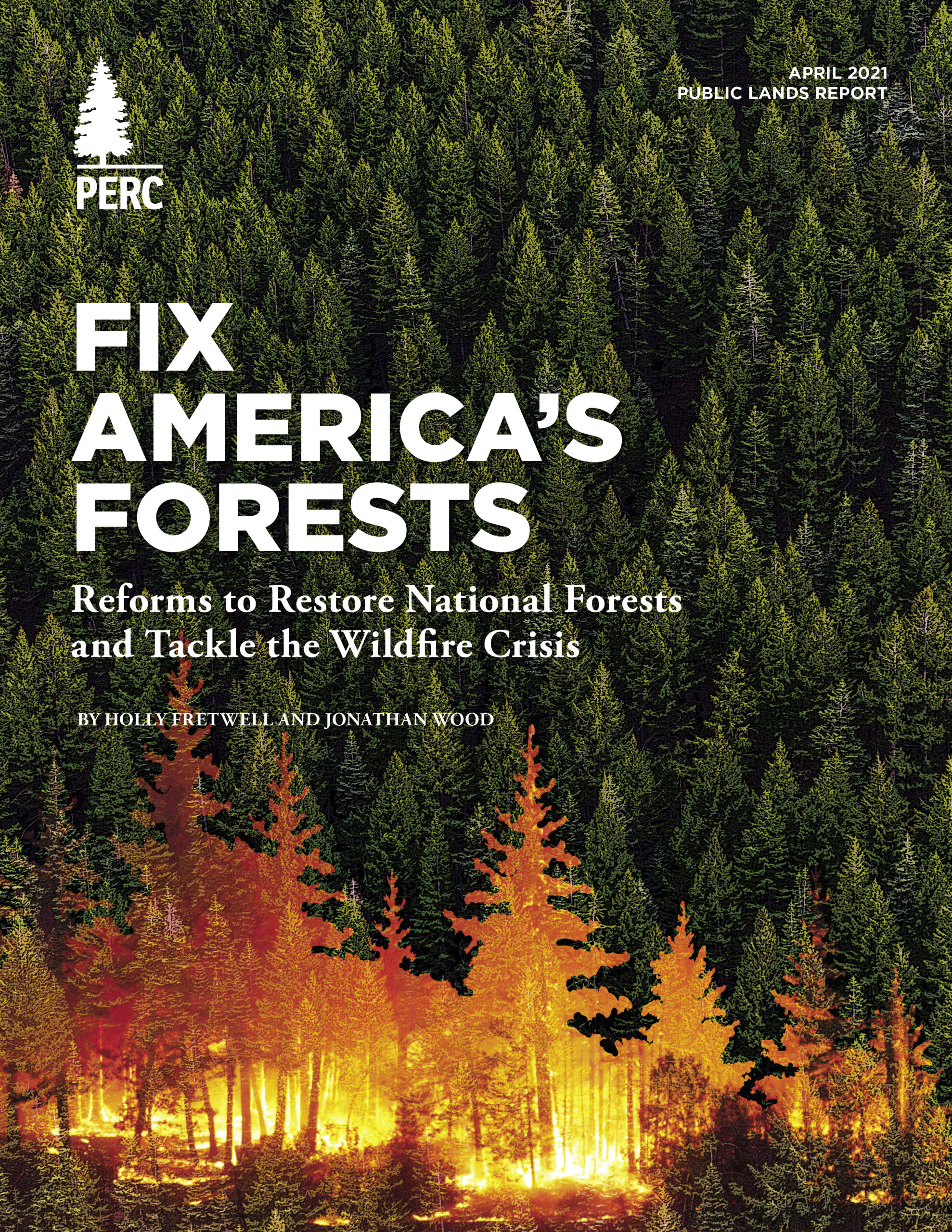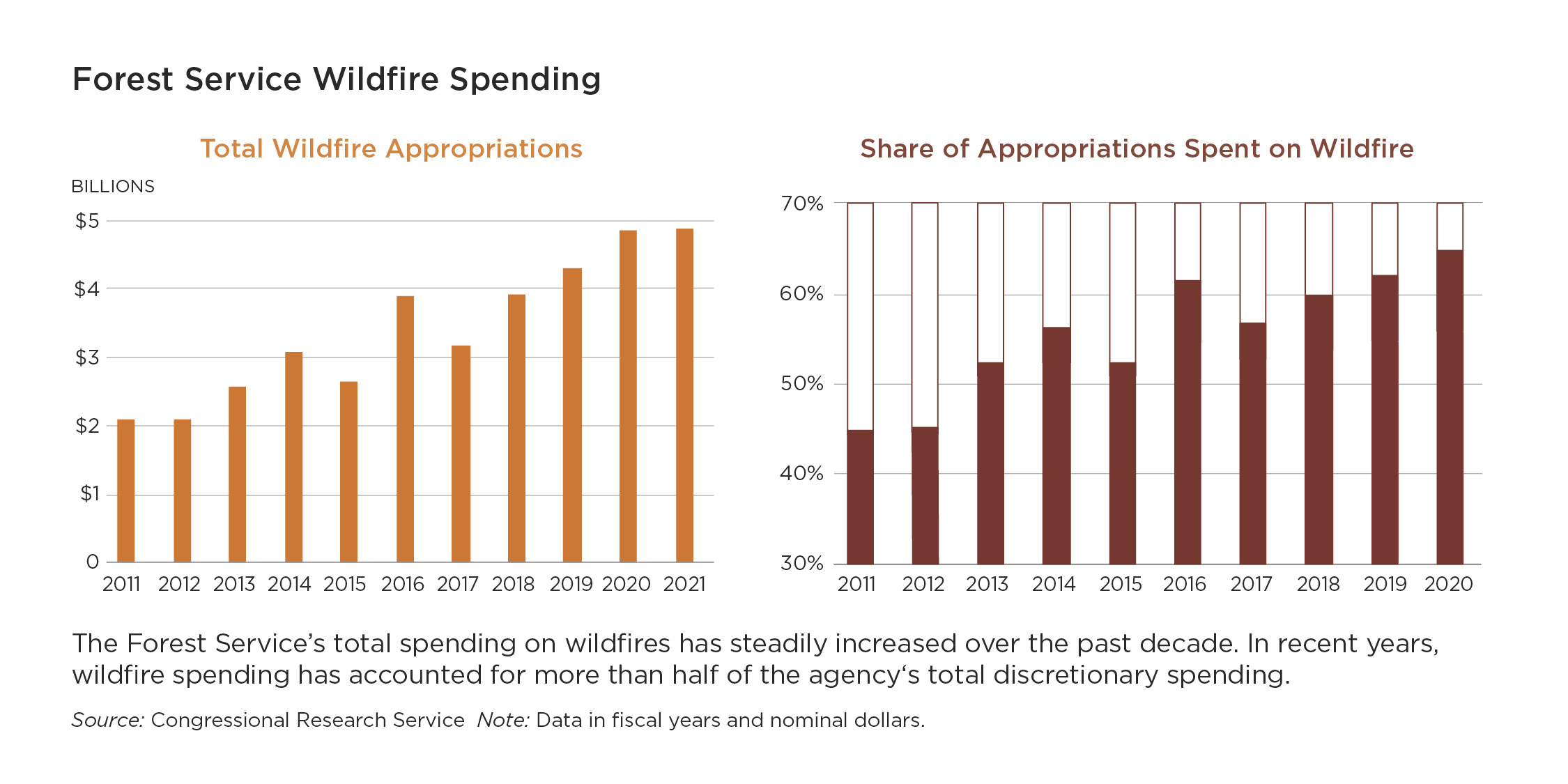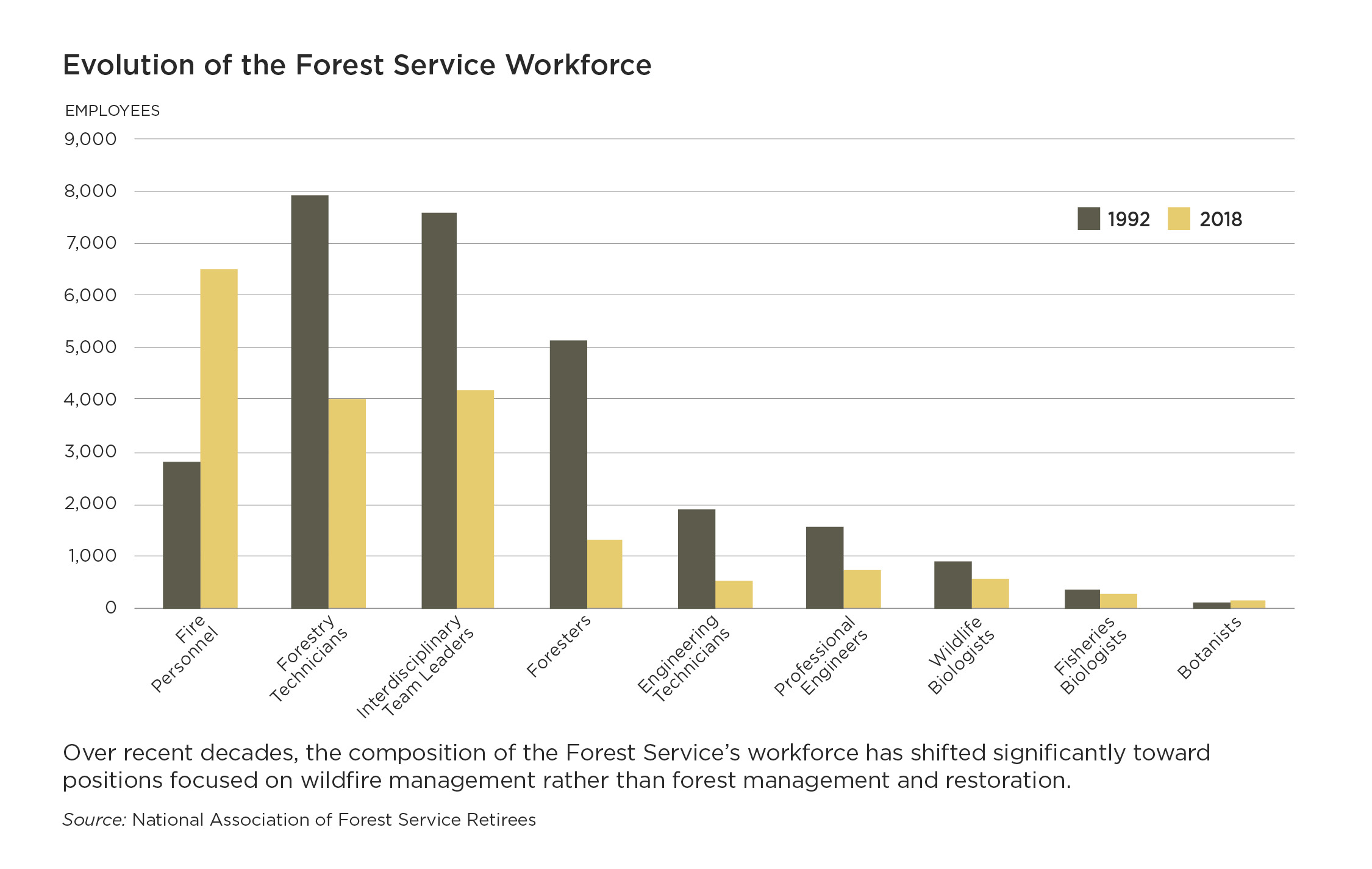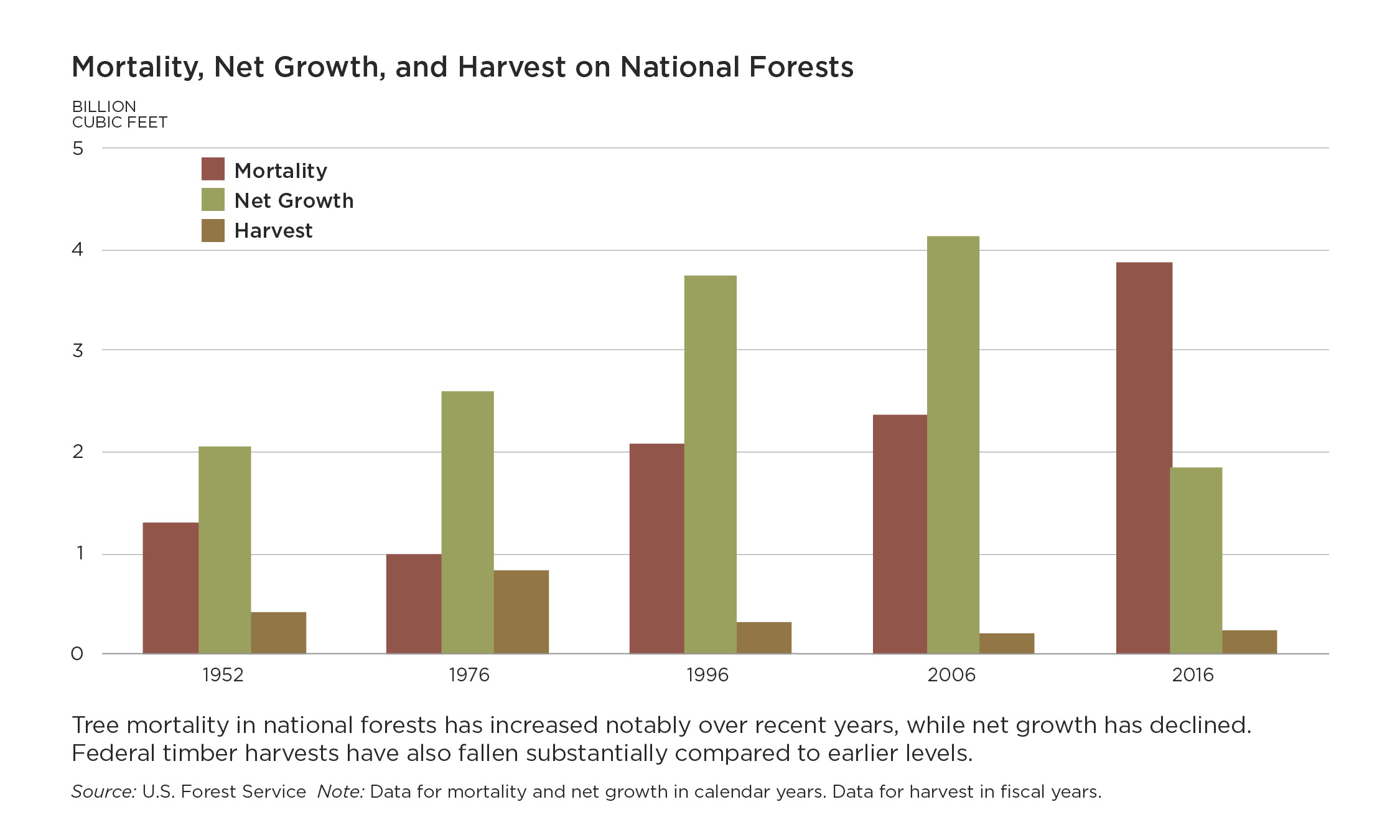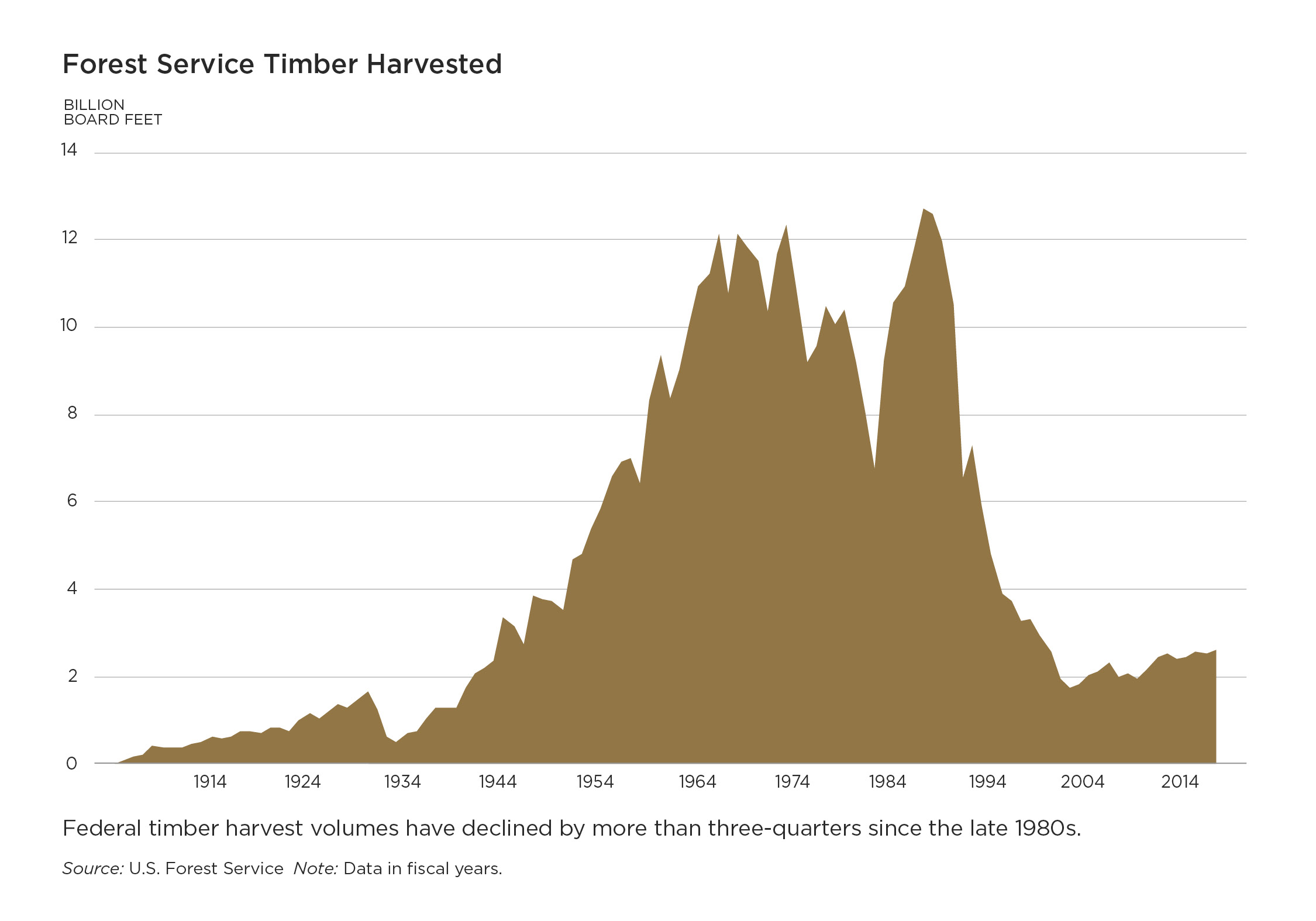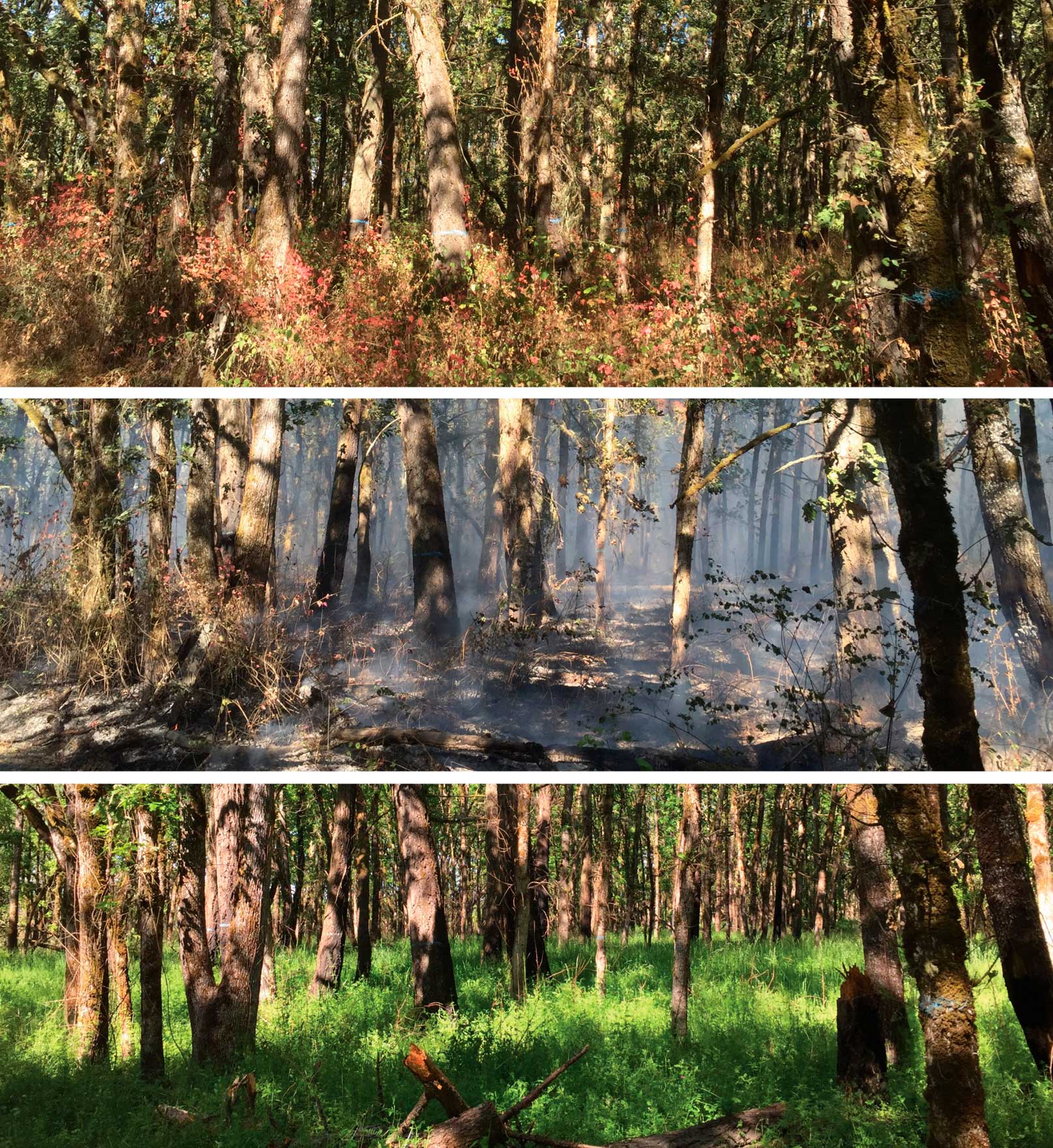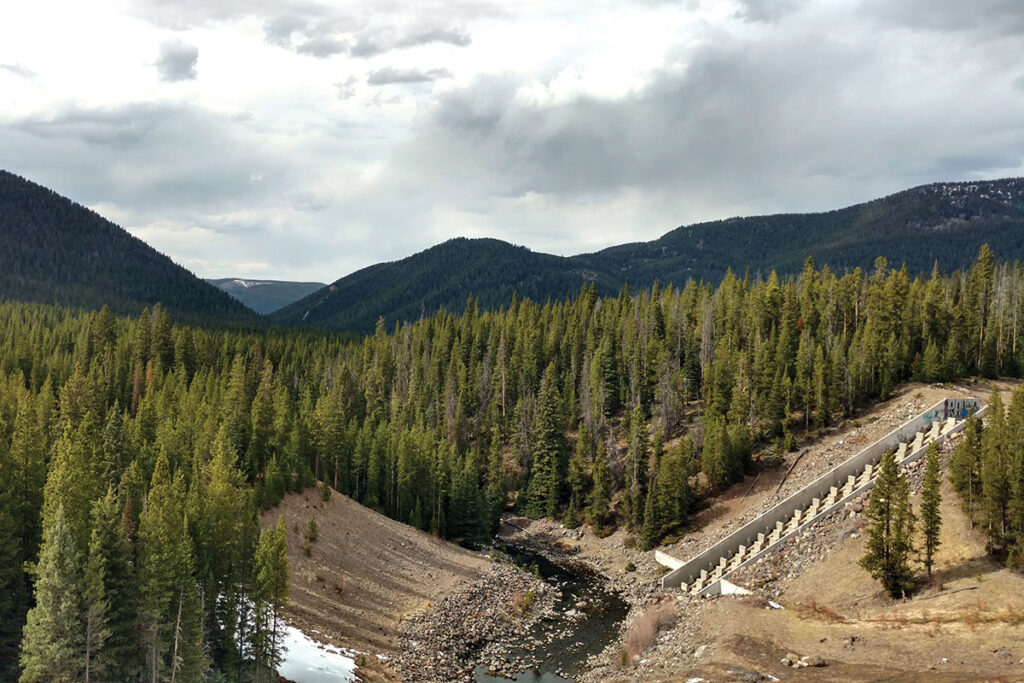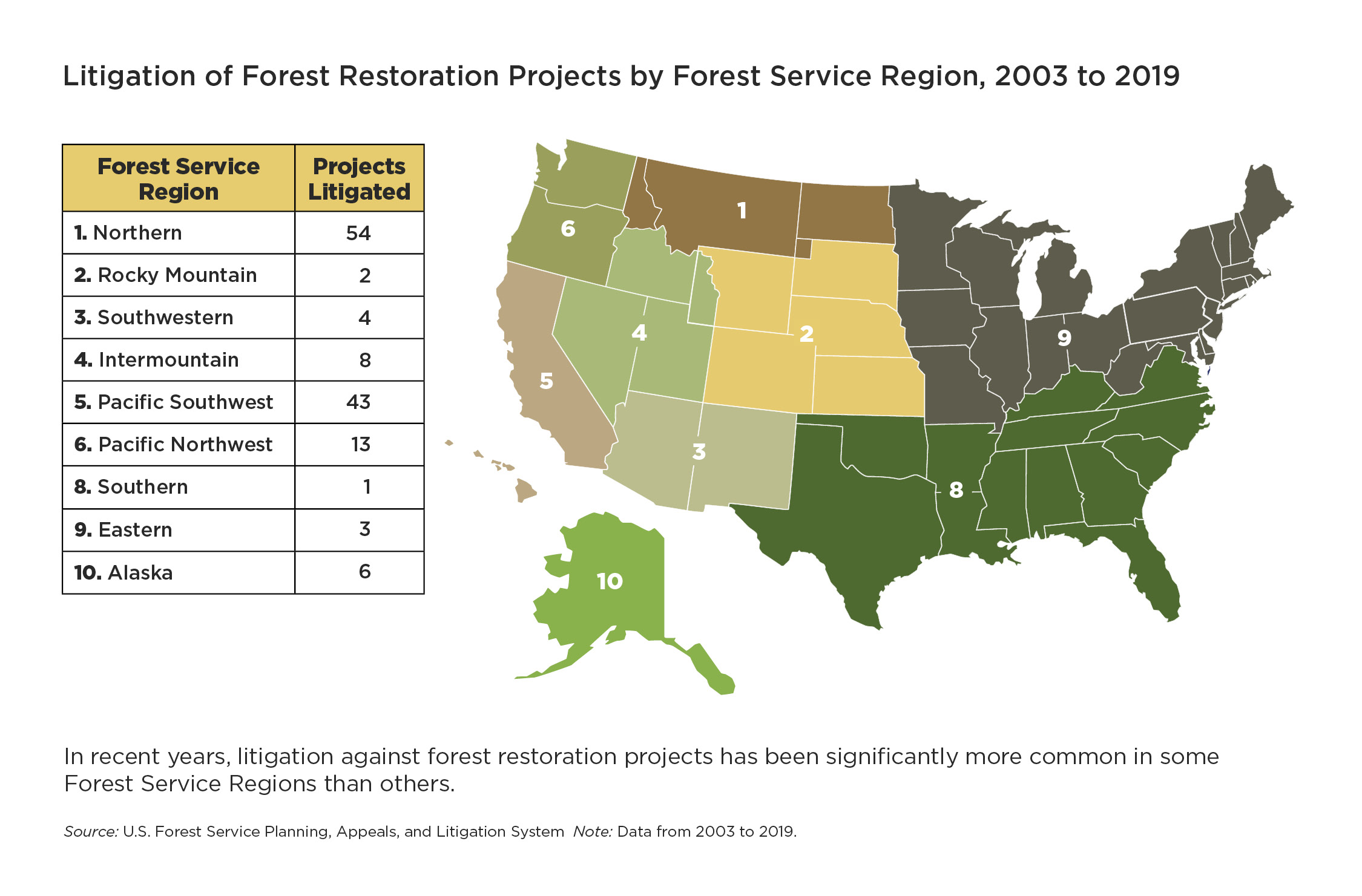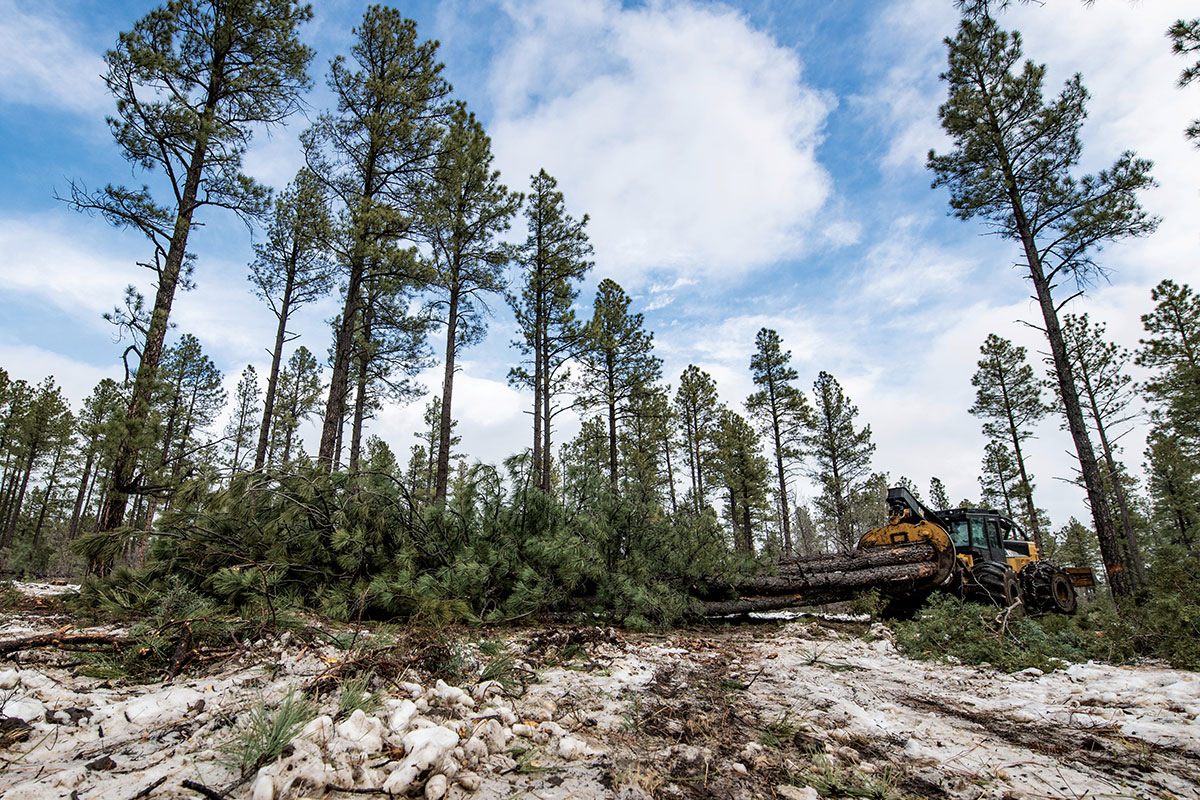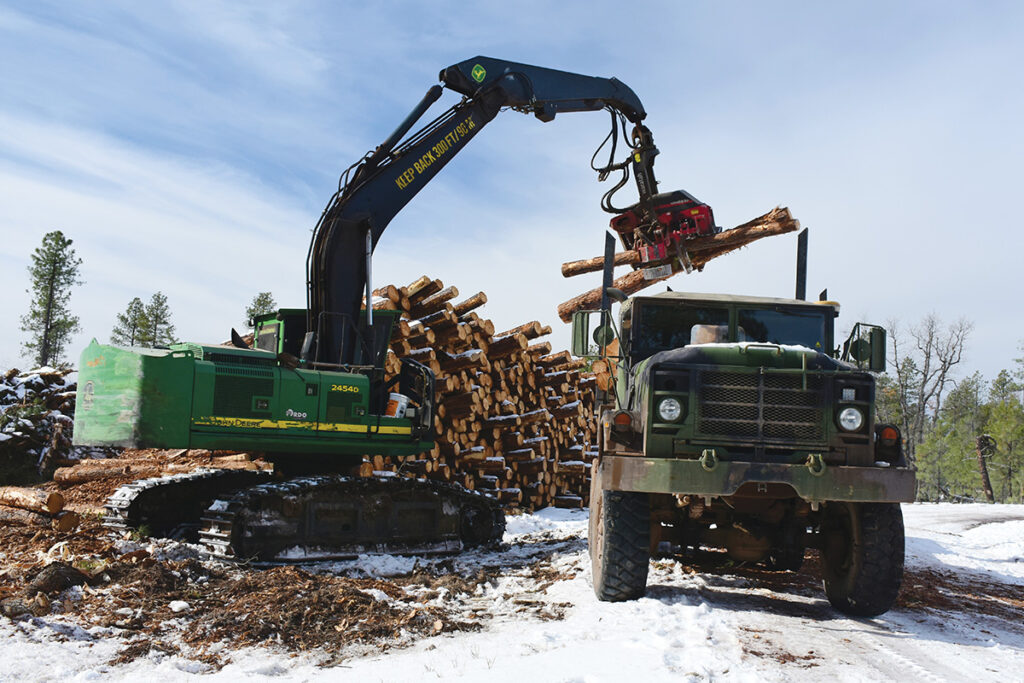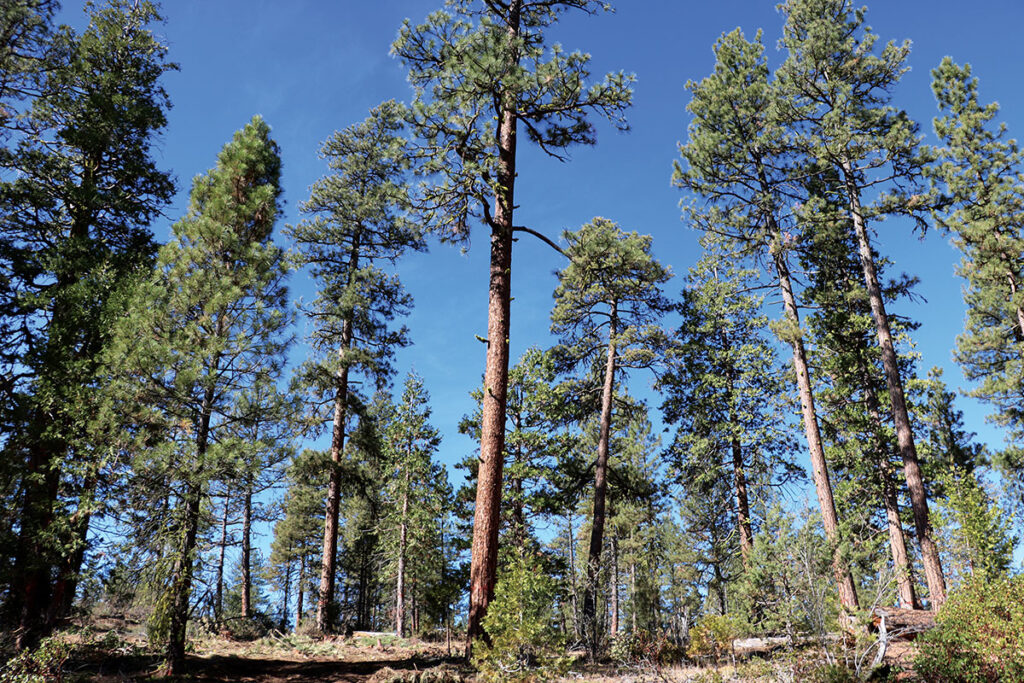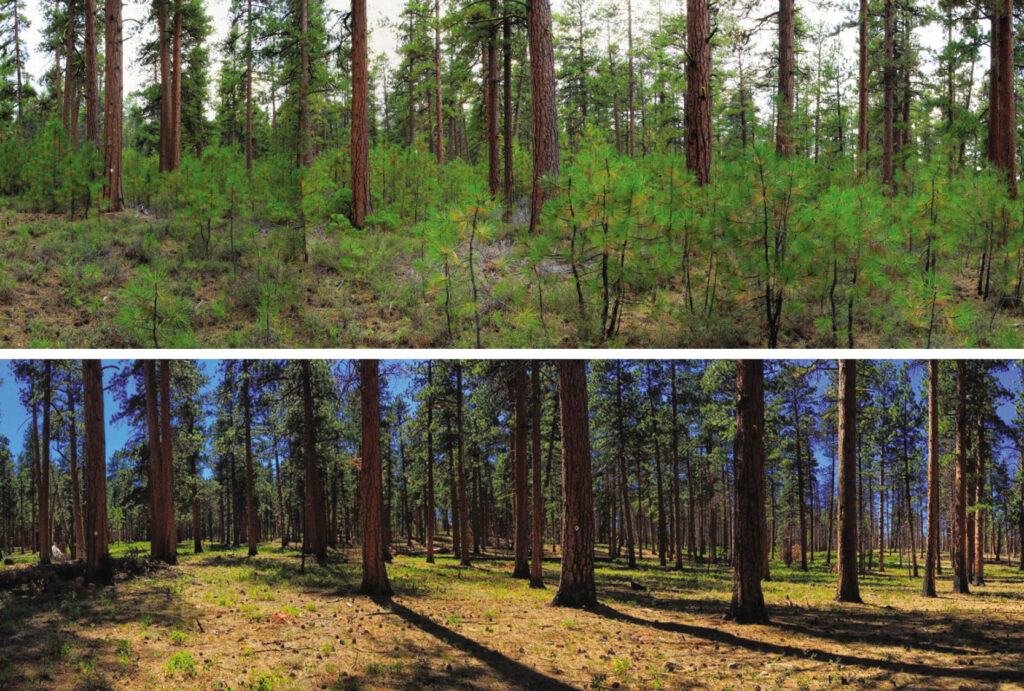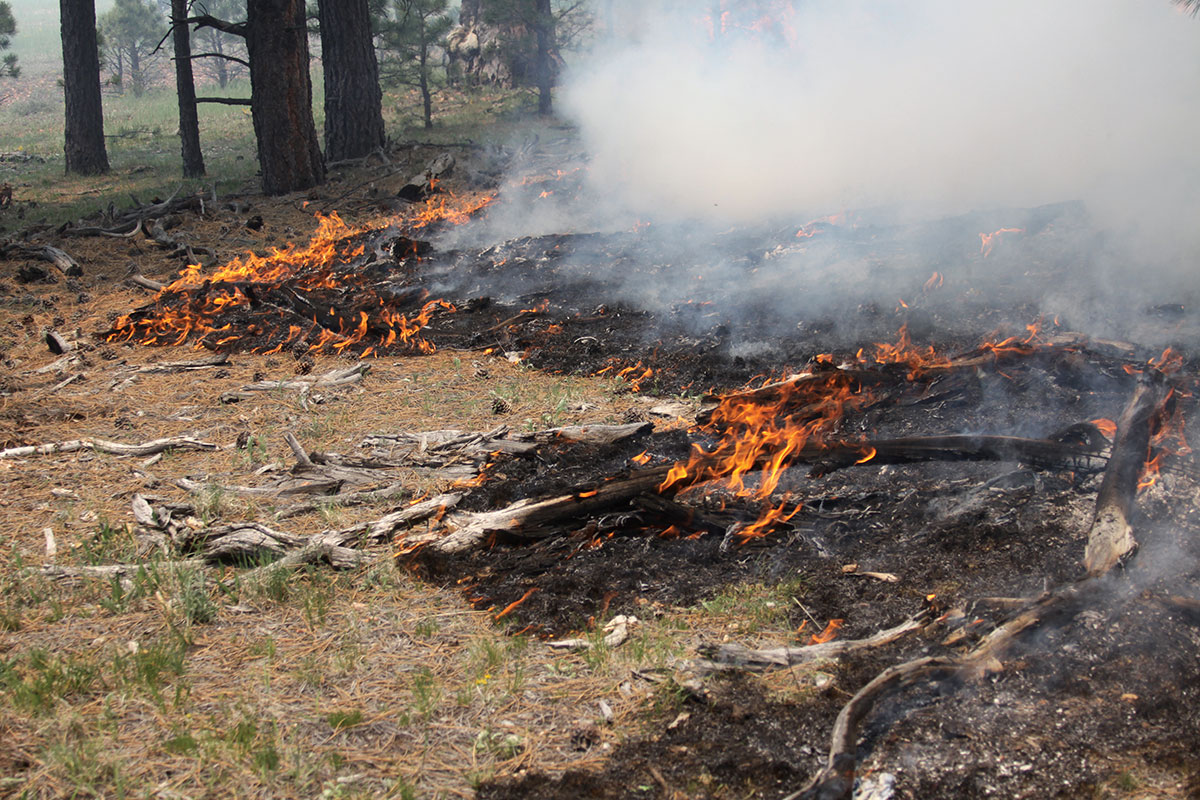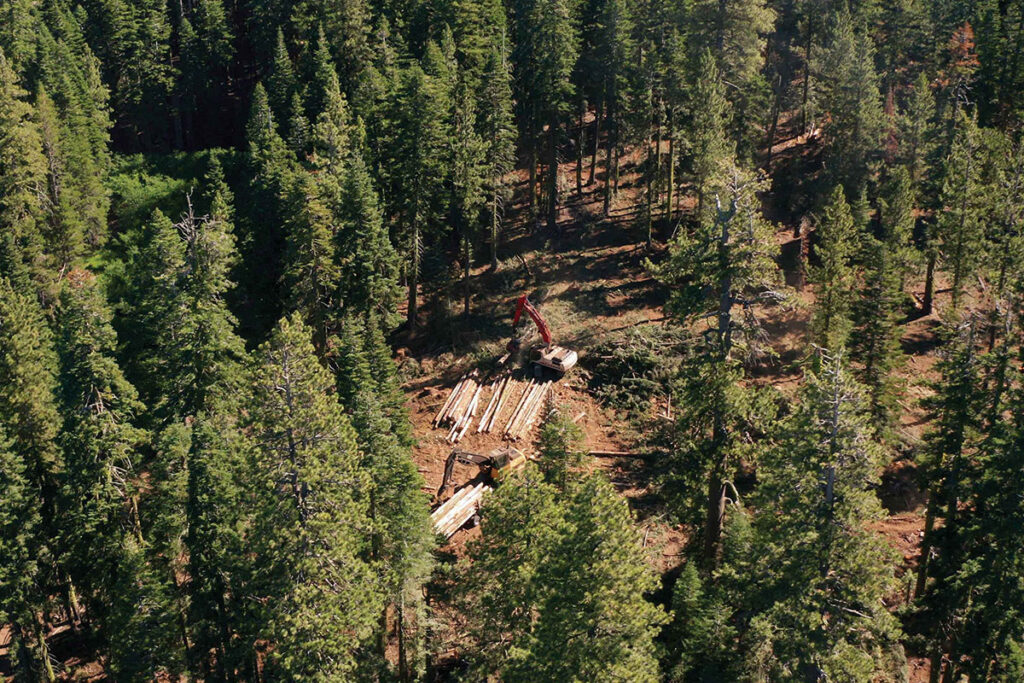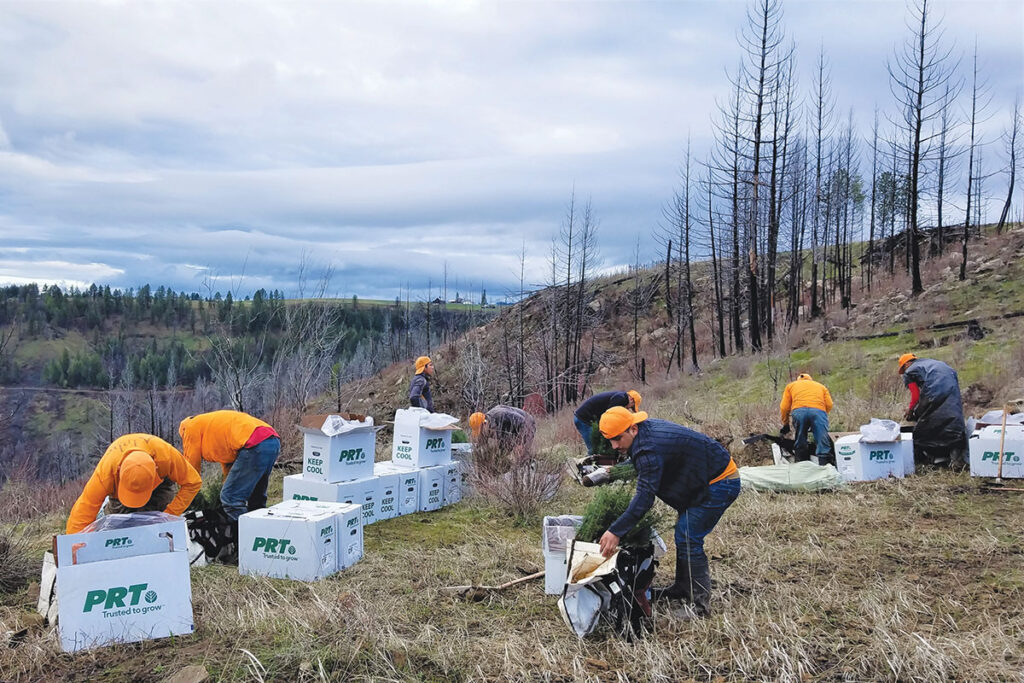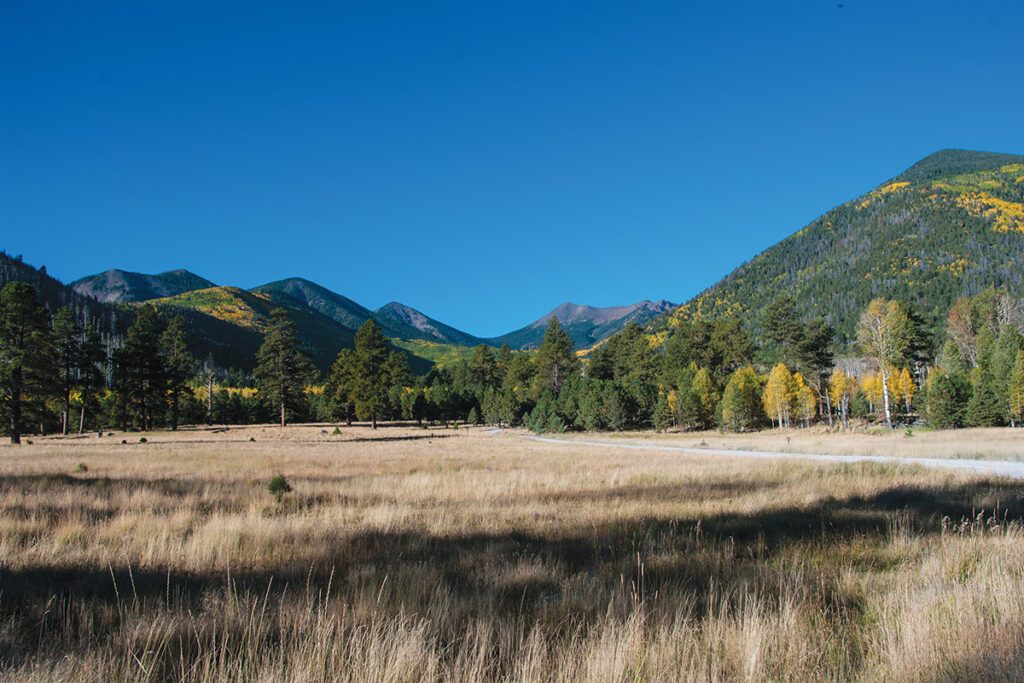 DOWNLOAD THE FULL REPORT
DOWNLOAD THE FULL REPORT
In 2020, the largest wildfire in California history scorched six counties in the northern part of the state. The August Complex Fire burned more than one million acres across three national forests and destroyed hundreds of structures. But devastating fires are not limited to California. Across the West, more than 10 million acres burned in 2020—a record in modern history. These fires consumed more than 17,500 structures and more than $3.5 billion in firefighting costs. Tragically, dozens of lives were lost, and many more people were displaced by evacuation orders. Fires released smoke that degraded air quality nearby and hundreds of miles away. They also destroyed wildlife habitat, including for imperiled species, and the fires’ aftereffects will soon lead to erosion that harms water quality in local watersheds.
Unfortunately, large and destructive wildfires are becoming more common across the West, with new records set almost every year. Although several factors contribute to this trend, a significant one is the declining health of the nation’s forests. The U.S. Forest Service, which manages 193 million acres of land, reports a backlog of 80 million acres in need of restoration and 63 million acres facing high or very high risk of wildfire.
Given the toll on neighboring communities, public health, and the environment, today’s extreme wildfire risks could readily be described as a nuisance. Yet the owner of the land posing this risk—the federal government—has not responded to these nuisance conditions the way any other landowner would be required to. From 2009 to 2018, the Forest Service implemented forest restoration projects to reduce fire risks and improve forest health on less than 4 million acres per year, including fuel reduction projects on only 1.4 million acres per year. At that pace, it would take decades to treat the areas at risk of catastrophic wildfire, ignoring any other risks that might arise in the interim.
At the current pace, it would take decades to treat the areas at risk of catastrophic wildfire, ignoring any other risks that might arise in the interim.[/pullquote]
Some factors that contribute to declining forest health and increasing fire risk, such as climate change, require long-term policy changes with benefits that will be realized only gradually. Forest restoration projects offer a way to mitigate these risks in the short term. One study led by Forest Service scientists estimated that of four factors driving fire severity in the western United States, live fuel “was the most important,” accounting for 53 percent of average relative influence, while climate accounted for 14 percent. Whatever the future course of climate change policy, the fact remains that many national forests have already accumulated decades worth of underbrush and fuels, escalating present fire risk. Forest restoration can help reduce these risks in the short run by creating and maintaining healthy, resilient forests and maximizing the ecological, environmental, and economic benefits people derive from them. By promoting landscapes with healthy forests and diverse forest types, restoration projects can reduce the risk of megafires and provide other conservation benefits.
The Forest Service’s ability to pursue forest restoration, however, is hampered by several obstacles, including limited funding, red tape, and litigation. Forest restoration is costly, and the agency’s budget for it has stagnated. Moreover, the Forest Service cannot easily leverage commercial timber harvesting to fund beneficial restoration work because harvesting has declined substantially, mill capacity near national forests is shrinking, and the brush and small-diameter trees that pose the greatest fire risks are often not marketable.
Fortunately, states, tribes, industry, and conservation groups that benefit from healthier forests have incentives to contribute funding, manpower, and other means of support. This report describes several innovative federal-state and public-private partnerships that have demonstrated the ability to increase and expedite needed restoration while promoting collaboration among diverse interests. These examples and others like them show the potential for markets, incentives, and collaboration to help overcome the forest restoration backlog and reduce alarming fire risks.
Innovative partnerships, however, can be disrupted or discouraged by the same bureaucratic obstructions, litigation risks, and other obstacles that hamper the Forest Service’s own forest restoration efforts. Drawing lessons from successful partnerships, this report recommends actionable reforms that can help the Forest Service work better with states, tribes, and private partners to fix America’s forests.
RECOMMENDATIONS
Encourage Collaboration Rather Than Conflict
1. Make categorical exclusions easier to apply and expand acreage limits.
2. Avoid analysis paralysis by limiting Endangered Species Act consultations to projects with on-the-ground impacts on protected species.
3. Make litigation less disruptive by requiring lawsuits to be filed quickly and clarifying how fire risks and forest health should affect injunction decisions.
4. Allow prescribed burns to be excluded from state emissions calculations.
Increase the Forest Service’s Ability to Partner with Others
5. Scale up public-private partnerships by empowering the Forest Service to enter longer-term contracts and cooperative agreements.
6. Allow the Forest Service to be a “Good Neighbor” through longer, more flexible partnerships with states, tribes, and counties.
Open Markets
7. Promote innovative wood markets by establishing a Forest Service restoration fund for long-term cost-share partnerships.
8. Open timber markets for export.
DOWNLOAD A TWO-PAGER EXPLAINER SUMMARY
SECTION I: THE CHALLENGES FACING OUR FORESTS
Various factors have contributed to the elevated fire risk facing many western forests. Forest restoration projects can lower the risk of wildfires and provide many other benefits, but several obstacles impede the Forest Service from accomplishing restoration work.
Growing Wildfire Risk and the Need for Forest Restoration
Historically, western forests were well adapted to frequent fires, which rejuvenated landscapes and prevented excess fuel from accumulating. Fires caused by lightning or intentionally lit by humans were common across the American landscape long before Europeans settled it. Beginning in the early 20th century, however, the Forest Service sought to quickly detect and suppress all fires in national forests. This approach was embodied in the “10 a.m. rule,” under which the Forest Service sought to suppress all fires by the morning after discovery.
Decades of suppressing all fires dramatically changed forest conditions. Forests that used to be characterized by frequent, low-intensity fires began to experience little or no fire. This led to greater forest density and increased tree mortality. Without frequent fires or other means to remove dead or dying trees, overgrown forests became more susceptible to insect infestation and disease. In 2015, the Forest Service estimated there were 6.3 billion dead standing trees in western forests. More frequent drought and climate change have exacerbated these deteriorating forest conditions and have extended the fire “season” into a year-round concern in many regions.
Despite the greater danger, more people live near western forests than ever before, compounding wildfire risks. Over the past 20 years, the “wildland-urban interface”—the place where wild areas and development meet—has expanded by more than 46 million acres. It now encompasses an area larger than Texas and contains more than 40 million homes. The shift has driven up fire-suppression costs, given the need to defend these increasingly populated areas when fires break out. It has also made more people and property vulnerable to the risks posed by wildfires. From 2005 to 2020, wildfires destroyed nearly 100,000 structures, with 62 percent of this damage done in 2017, 2018, and 2020 alone.
The extreme wildfires of today also have significant environmental consequences. They release clouds of smoke that degrade air quality for hundreds of miles. They emit significant amounts of carbon dioxide, converting forests from carbon sinks into carbon sources. In the wake of extreme wildfires, increased erosion can worsen water quality, including drinking water. This erosion also harms watersheds and the fish and wildlife that rely on them. Similarly, forested areas damaged by intense fire may no longer be suitable habitat for wildlife, including endangered species.
Forest restoration can reverse these trends and promote healthier, more resilient forests. Restoration activities can involve mechanical thinning and prescribed burning to mitigate immediate wildfire risks by reducing forest density and removing overgrown brush. It can also involve replanting native trees, removing invasive plants, and addressing erosion risks to help forests recover from fire. Forest restoration enhances conservation and other values by increasing forest diversity, preventing the spread of disease and insect infestations, and improving the functioning of wetlands and streams. Additionally, forest restoration can reduce net carbon emissions by avoiding massive wildfires and by sequestering more carbon in forests through regeneration.
There is growing bipartisan support for proactive forest restoration. Recently, Senators Steve Daines (R-Mont.) and Dianne Feinstein (D-Calif.)—two members of Congress not typically aligned on policy issues—have cosponsored legislation aiming to ramp up forest restoration. Congressmen John Curtis (R-Utah) and Joe Neguse (D-Colo.) also launched the Bipartisan Wildfire Caucus in February 2021 to bring Democrats and Republicans together to help reduce the risk of catastrophic wildfire. These efforts are important, but much more will need to be done to overcome obstacles to restoring the nation’s forests.
Obstacles to Forest Restoration
Despite the interest in forest restoration and its benefits to forest health and wildfire risks, the pace of restoration has not kept up with the need. The Forest Service has identified 80 million acres in need of restoration, most of which are at high or very high risk of burning. But the agency has recently performed this work on less than 4 million acres per year. At this rate, it will take decades to clear the backlog, never mind the additional restoration needs that will arise in the interim. This substantial backlog has arisen because the Forest Service faces significant obstacles to ramping up forest restoration.
From Forest Service to Fire Service
As fires have grown larger and more destructive, firefighting has become the Forest Service’s predominant focus. In the 1980s to mid-1990s, an average of 2.9 million acres burned each year, and firefighting costs consumed 16 percent of the Forest Service’s budget. Twenty years later, 6.5 million acres burned annually, with wildfire operations consuming half the agency’s budget.
The Forest Service’s shift from primarily managing forests to primarily fighting fires has limited the amount of restoration work the agency can do. Until recently, whenever fire-suppression costs exceeded the amount Congress budgeted, the agency covered the difference through “fire borrowing,” a euphemism for raiding other programs to fund firefighting efforts. The programs that suffered most, according to the agency, were “often those that improve the health and resilience of our forested landscapes and mitigate the potential for wildland fire in future years.”
Congress recently passed legislation that aims to end this practice by establishing a separate wildfire disaster account for the agency, which receives more than $2.25 billion annually. While this reform could end fire borrowing, it does not address the underlying causes of catastrophic fire conditions, nor will it free up funding for forest restoration projects at the pace and scale needed. Indeed, the Forest Service estimates that the number of acres burned annually may double by mid-century, an outcome that could not be mitigated by a disaster account.
Agency staffing also reflects the shift in focus. The total number of Forest Service employees has declined by 35 percent since 1992, although positions that focus on wildfire management more than doubled over that period. Staff who support forest management and restoration, on the other hand, were cut by more than half. The reduction in forest staff diminishes the capacity of the agency to plan, design, and implement restoration projects. A 2019 survey of agency managers across all forest regions concluded that “it is readily apparent that the Forest Service cannot meet national direction to increase the pace and scale of forest restoration with its current workforce.”
Shifting Economic Challenges
Forest restoration plans can sometimes involve commercial timber harvests, an approach that generates revenues to help offset the restoration costs. Timber harvesting can also, in theory, provide direct benefits to forest health when it mimics fire’s role by removing dead and diseased trees and preventing overgrowth. The evolving goals of federal timber harvests over recent decades, however, have not focused on this approach. In fact, federal harvest volumes have fallen substantially, and today, tree mortality in national forests exceeds the amount of material removed from them through harvests. The lower level of federal harvesting means fewer revenues are generated that could help finance forest restoration.
Harvest levels have declined sharply, from 12 billion board feet in 1988 to less than 3 billion board feet in recent years, with collateral consequences for the timber industry. Several factors caused the Forest Service to cut less timber, including broad economic trends, policies that favored ecosystem management over commercial harvests, and growing opposition to timber harvest from environmentalists. In the late 1980s, federal timber harvests made up about 40 percent of all western harvests; by 2003, they represented less than 10 percent. This caused an overall decrease in softwood timber harvest in the West, forcing mill closures. As a result, the region’s timber-processing capacity declined by 37 percent between 1986 and 2003, though some areas were more affected than others.
In some regions, like the Pacific Northwest, mill capacity remains significant, and removable timber retains substantial value, so commercial timber harvests can subsidize restoration activities. In many other areas, however, projects struggle for financing because mill capacity is lacking, timber value is low, or both. The four-corners region of the Southwestern United States, for example, has seen a huge loss in capacity and now has only a small forest products industry. The lack of capacity presents a challenge to restoring forests in the region. There is simply not sufficient milling infrastructure to process vegetation removed to reduce fuels.
Additionally, restoration in many areas would entail the removal of small trees and woody biomass, material with little commercial value. Markets for biomass, such as bioenergy, biochar, and other value-added products, could help offset the costs of treatment, but these markets are just emerging and require large infrastructure investments. Investment in processing facilities is often too great a risk, however, without more certainty about a continuous supply of materials from federal forests.
An alternative to processing timber locally could be to sell unprocessed logs overseas, but export restrictions that date to the 1960s eliminate that option for timber from federal forestlands in the West. Although intended to protect the domestic processing industry, the trade restrictions limit the number of potential buyers and reduce demand for federal logs today.
Burdensome Red Tape
The Forest Service’s capacity to pursue forest restoration is also constrained by regulation and bureaucracy. Although well-intentioned, environmental regulations can have the unintended effect of discouraging environmentally beneficial actions, including those to restore forests and reduce fire risk.
The National Environmental Policy Act (NEPA), for instance, requires federal agencies to document and analyze the expected environmental impacts of their actions. The extent of analysis required can vary based on the degree of anticipated impacts. But for any project, NEPA compliance adds costs and can be a source of significant delay. For the most complicated category of projects, which includes large-scale forest restoration projects, NEPA paperwork takes an average of nearly three years to prepare.
Recognizing the environmental, economic, and other consequences of delay, Congress has authorized “categorical exclusions” to exempt from NEPA requirements projects with predictable environmental impacts. The requirements for categorical exclusions vary considerably. But the ones relevant to forest restoration generally limit the size of projects (to 3,000 acres at most) and have vague standards concerning collaboration and environmental impacts. Again, although well-intentioned, these requirements restrict the agency’s capacity to perform forest restoration. Demonstrating that a project qualifies for a categorical exclusion, for instance, takes an average of roughly 7 months. And forest restoration projects are considerably less likely to qualify for a categorical exclusion than other Forest Service projects.
The Endangered Species Act can also increase the cost and time required for forest restoration. Whenever an agency decision may affect a listed species or its critical habitat, the Endangered Species Act requires the agency to “consult” with the U.S. Fish and Wildlife Service, a process that entails thoroughly documenting potential impacts and analyzing potential modifications or mitigation measures. Fortunately, federal agencies have become adept at designing projects to ensure that they will not ultimately be blocked during consultation. However, the process can still entail significant delays. Indeed, for much of the West, the consultation requirement can inject recurring delays. The Ninth Circuit Court of Appeals has held that the Forest Service must consult not only over individual projects but also when it develops general management objectives and policies in a forest plan, even though such plans have no on-the-ground impacts. Moreover, as held in Cottonwood, consultation must be reinitiated at both levels whenever there is a subsequent regulatory development, like a new species listing or critical habitat designation.
Finally, environmental regulations disfavor impacts from forest restoration projects compared to impacts from wildfires, disease, and insect infestations. Wildfires obviously do not wait for or abide by NEPA and Endangered Species Act analyses. But there are additional ways that environmental regulations can give short shrift to the adverse consequences of inaction. The Clean Air Act, for instance, limits when prescribed burns can be implemented. The act, however, considers wildfires to be “exceptional events” and therefore exempts from regulation smoke emitted by them. While this may have once made sense, wildfires and the smoke they cause are anything but exceptional today. Consequently, the adverse treatment for prescribed burns, which reduce smoke and air pollution by precluding massive wildfires, is difficult to justify.
Tanglesome Litigation
While litigation plays an important role in holding the government accountable, it can also be disruptive and warp incentives. It can encourage conflict rather than collaboration, especially where the government pays its opponents’ attorney’s fees. And it can elevate relatively minor scientific or policy disagreements over broader considerations of forest health and the public interest.
Litigation has tied the Forest Service in what former chief Jack Ward Thomas described as a “Gordian knot” by limiting the agency’s ability to actively manage national forests. Forest restoration projects are substantially more likely to be litigated than other Forest Service projects. But the adverse consequences of litigation are not limited to projects that end up before courts. Forest Service personnel report that the mere risk of litigation can affect project analysis, costs, and delays.
These consequences are not evenly distributed. For some Forest Service regions or national forest units, litigation is only an infrequent obstacle. Yet for others, it is an ever-present consideration. Litigation is a particularly disruptive factor for national forests within the Ninth Circuit Court of Appeals—which has jurisdiction over West Coast states as well as Montana, Idaho, Nevada, and Arizona—and near communities with litigious local or special-interest groups.
The Bozeman Municipal Watershed Project demonstrates the worst-case scenario of red tape and litigation combining to delay a restoration project. In 2004, the Forest Service and the city of Bozeman, Montana, recognized that wildfire risks in the Custer-Gallatin National Forest threaten 80 percent of the city’s water supply. Three years later, the agency released its draft NEPA report for comment. In 2009, a federal court in an unrelated case reversed the delisting of the local grizzly bear population, triggering the Endangered Species Act’s consultation requirement for the project. In 2010, six years after recognizing the urgent need for the project, the Forest Service completed its NEPA and Endangered Species Act analysis and formally approved the project.
But that six-year sojourn proved to be only the beginning. Three local groups challenged the agency over the project on procedural, environmental, and other grounds. While that challenge was pending, the Ninth Circuit decided several cases that meant additional analysis would be required for projects like the Bozeman Municipal Watershed Project. In 2011, the Forest Service completed this additional analysis and affirmed its earlier approval of the project.
A year later, a lawsuit was filed challenging that decision. Meanwhile, nearly 10,000 square miles of land within the Greater Yellowstone area were designated as critical habitat for the Canada lynx, and the Ninth Circuit held in 2015 that this development required yet more analysis for the project. The Forest Service completed the analysis and, again, affirmed its approval of the project. Consequently, in 2020, a federal court lifted the injunction that had been blocking the project. That decision has since been appealed, and when the project might finally begin remains in doubt.
SECTION II: STATES AND PRIVATE PARTNERS TO THE RESCUE
Healthy forests provide numerous benefits to neighboring communities, tribes, industry, and conservationists. Consequently, these stakeholders have incentives to help tackle the forest restoration backlog. Working with such partners, the Forest Service has undertaken several innovative projects that have increased the pace and scale of restoration. Through collaboration, it has also sought to speed up project reviews and approvals by proactively addressing sources of conflict before they cause delay.
As the following examples demonstrate, some of these innovations have been more successful than others. Although these examples remain exceptions to the norm, they provide blueprints for progress and suggest reforms that can make it easier for state and private interests to contribute to and speed up forest restoration.
Paying Up for the Benefits of Healthy Forests
In Northern Arizona, several national forests provide many benefits to the state and surrounding communities, including supplying drinking water, promoting a growing outdoor recreation economy, and conserving a diverse mix of wildlife and ecosystems. These values, however, are threatened by wildfire, declining forest health, and limited federal funding for forest management and restoration.
The National Forest Foundation, a congressionally chartered nonprofit, and the Salt River Project, a utility company, formed the Northern Arizona Forest Fund to encourage state and private investment in these national forests and the valuable benefits they provide. For the Salt River Project, for instance, investing in forest and watershed restoration can reduce its water treatment costs and protect its water storage capacity. The fund supports forest restoration work within five forests: Apache-Sitgreaves, Coconino, Kaibab, Prescott, and Tonto National Forests.
Since 2015, the Northern Arizona Forest Fund has raised more than $6.2 million for forest restoration. To avoid the expenses and delays associated with bureaucracy and litigation, the fund focuses its efforts on “shovel-ready” projects—ones that have already been developed by the Forest Service, completed all environmental reviews, and been identified by the agency as a priority. To date, the fund has performed fuel reduction projects on 13,600 acres in three national forests, improved 2,600 acres of wetlands, planted 90,000 trees, and reduced erosion along 170 miles of roads and trails.
A wide variety of public, private, and nonprofit organizations have contributed money or in-kind services to the fund, including the Arizona Department of Fish and Wildlife, the cities of Scottsdale and Phoenix, Coca-Cola, businesses dependent on outdoor recreation, and conservation groups. From the perspective of these partners, paying for forest restoration today is much better than suffering the consequences of wildfire tomorrow. Based on the success of the Northern Arizona Forest Fund, the National Forest Foundation has established a similar partnership—the Southern Arizona Forest Fund—to finance forest restoration projects in the Coronado National Forest.
To scale this innovation, similar opportunities to raise private funds from states, tribes, business, and conservation groups need to be identified. Fortunately, the Forest Service recognizes the benefits of this model and has developed a mapping program to identify areas where such opportunities exist. To extend the model beyond shovel-ready projects, however, it will also be necessary to address the expense and delays associated with red tape and litigation.
Key Implications:
- The benefits that flow from healthy forests can give surrounding communities, local businesses, residents, and conservation groups incentives to help fund and implement forest restoration projects.
- Because of the expenses and delays associated with environmental reviews and litigation, shovel-ready projects are most appealing to private contributors.
Financing Forest Restoration with Private Bonds
Although forests provide numerous benefits to many people and groups, raising funds to pay for forest restoration can present a difficult timing challenge: Significant money must be raised and spent now for anticipated benefits years into the future. Innovative private financial instruments can deal with this challenge by spreading the costs of forest restoration over the period during which the benefits are realized.
Two nonprofit organizations, Blue Forest Conservation and the World Resources Institute, have developed the Forest Resilience Bond, which relies on private investment capital to fund forest restoration. The bond’s investors recoup their money and a reasonable return from the project’s beneficiaries according to a contract negotiated in advance. This financing structure allows local governments, utilities, and private businesses to essentially borrow against the future benefits they will receive from healthier forests rather than having to raise all the funds upfront themselves.
The first Forest Resilience Bond was developed in 2018 to fund a shovel-ready forest restoration project in California’s Tahoe National Forest. Blue Forest Conservation chose a shovel-ready project as its pilot to avoid the risk that NEPA and other red tape would delay or jeopardize the project and ensure that investors did not influence the Forest Service’s project design.
The State of California and Yuba Water Agency, a utility company, signed contracts, agreeing to pay back the bond as restoration work is completed and benefits are achieved. The Forest Service did not have capital available to contribute to the project upfront, and federal law prevents the agency from making financial commitments in advance of appropriations. The agency is instead providing in-kind support for the bond, including planning, development, and execution. The National Forest Foundation is managing the project.
The Yuba Forest Resilience Bond raised $4 million to fund restoration projects on 15,000 acres. Its investors are two nonprofit foundations, an impact investing firm, and an insurance company. With many investors showing increased interest in the environment, forest bonds offer an attractive mix of potential income and public benefit. The bond will disburse payments to the National Forest Foundation for work to control invasive species, remove small-diameter trees and brush, and carry out prescribed burns.
The Forest Service estimates that the Forest Resilience Bond will allow the project to be completed in only four years, rather than the 10 to 12 years the agency had projected. In a region where 10 million acres can burn in a single year, expediting projects is an enormous benefit. For that reason, similar initiatives are already being developed to fund forest restoration in other national forests.
In the long term, parties interested in developing Forest Resilience Bonds may want to help design forest restoration projects. For instance, the Forest Service might favor one plan if the project will be dependent on timber revenues to pay for forest restoration and another if conservation groups will be bearing the costs. Yet bureaucratic and litigation delays still present significant risks. Such obstacles can mean increased expense, a diminished chance of a return, and uncertainty about when or whether a project will move forward. These risks could be the difference between a bond being funded—and forest restoration occurring—or not.
Key Implications:
- Forest Resilience Bonds can provide immediate funding for forest restoration, increasing the pace and scale of projects.
- The Forest Service’s ability to participate in these bonds is limited by appropriations rules that forbid long-term financial commitments.
- Bureaucratic delays and litigation risk could limit private finance to shovel-ready projects.
Accelerating Restoration Through Collaboration
In 2010, the Forest Service and the 4FRI Stakeholders Group, a diverse mix of tribal, business, and conservation interests in Arizona, established the Four Forest Restoration Initiative (4FRI) with the goal of restoring 2.4 million acres within the Apache-Sitgreaves, Coconino, Kaibab, and Tonto National Forests. These forests had been the subject of recurring and sometimes bitter land-use conflicts. One of the first and largest initiatives developed under the Collaborative Forest Landscape Restoration Program established by Congress in 2009, 4FRI sought to resolve this conflict through collaborative, science-based forest restoration and a long-term “stewardship” contract.
In 2012, the first 4FRI contract was issued, providing for restoration of 300,000 acres over 10 years through mechanical thinning of small-diameter trees and prescribed burns. While Forest Service timber contracts generally provide only three years for harvest to be completed, stewardship contracts combine commercial timber sales with complementary restoration work and cover a longer term to allow for this additional work. This initial 4FRI contract consisted exclusively of shovel-ready projects. Unfortunately, this first phase of the project got off to a rocky start. Some stakeholders strongly disagreed with the contractor chosen by the Forest Service, that contractor was unable to secure funding, and the contract had to be reassigned to another company. Furthermore, a market for small-diameter trees did not develop as fast as hoped. This last challenge is critical because 4FRI’s model depends on matching funds from the sale of forest products to help pay for forest restoration.
Recognizing that its ambitious goals could not be met from shovel-ready projects alone, 4FRI also worked with the Forest Service to identify and develop additional forest restoration projects. These projects, however, would require 4FRI’s disparate group of stakeholders to navigate the NEPA process. To minimize conflict, the Forest Service proactively met with each of the nine parties who objected to the agency’s NEPA analysis, discussing their objections in detail. After considering feedback it received, the agency finalized its NEPA report in 2015, addressing and resolving the objections. Ultimately, the agency analyzed the condition of one million acres within national forests and recommended restoration projects covering 580,000 acres.
As 4FRI approaches its second decade, it has proposed a second restoration contract that would allow 20 years to perform the restoration work identified in the NEPA process. The longer stewardship contract is intended to provide greater incentive and confidence for companies to invest in mills that can process small-diameter trees, which account for much of the material that needs to be removed from the national forests. The extended timeline would also allow for continued development of various wood product industries that use such material, including mass timber building and bioenergy production. Uncertainty about the reliability of supply from forest restoration projects is a significant obstacle to such investment. Furthermore, it is often difficult to secure upfront financing from private investors without a financial commitment from the Forest Service. Yet while the agency can agree to stewardship contracts that last up to 20 years, it cannot actually commit funds to work covered by such a contract more than a few years ahead of time. Appropriations rules and the Antideficiency Act prevent the agency from making such long-term financial commitments, exacerbating uncertainty about supply.
Key Implications:
- Collaborative approaches involving an array of stakeholders can resolve conflict and lessen expenses, delays, and litigation.
- The lack of markets for small-diameter woody materials reduces the economic viability of restoration projects.
- Without reliable supply and long-term contracts, the investment and innovation needed to make forest restoration profitable may not occur.
Being a Good Neighbor to States, Tribes, and Communities
In 2001, Congress created the Good Neighbor Authority to allow the Forest Service to partner with states, tribes, and counties on forest management. Under these agreements, state, tribal, and county partners can assist with and even take the lead on projects on federal lands, including planning, restoration, and timber sales. In return, state partners receive a share of timber revenues or direct federal compensation.
Idaho has taken an active role using Good Neighbor Authority (GNA) to increase the pace and scale of forest restoration on federal lands in the state. Between 2016 and 2020, Idaho Department of Lands signed onto six GNA agreements covering dozens of projects across five national forests. The state has already helped the Forest Service treat over 17,000 acres, with 10,000 additional acres in the planning stage.
Through these GNA projects, the state has helped reduce fuels, manage controlled burns, complete road repair, remove damaged and diseased trees, and replant drought- and insect-tolerant species. Funding from the state legislature, forest industry, and Forest Service, combined with revenues from previous GNA timber sales, have financed these successes. Given the growth of the program, Idaho Department of Lands has added four full-time staff specifically to assist with GNA projects. The agency has completed 20 timber sales under the authority and is developing 10 additional sales. Over the next three years, the department expects to generate program revenues in excess of $7 million, which will be devoted to future GNA projects.
As GNA programs have expanded, agencies in several other states have hired staff to help implement projects. The volume of timber sold from all GNA projects doubled from 2018 to 2019, when it comprised more than five percent of all federal timber sold. In 2020, GNA timber sales represented 11 percent of the volume sold in Region 1.
GNA has enabled states like Idaho to make progress restoring forests, but the program has several notable limitations. While state agencies can retain and use revenues earned from timber harvests to fund future GNA projects, the revenues must be spent by the end of the GNA agreement, which is a stewardship contract limited to 10 years. Furthermore, only states, not counties and tribes, can collect receipts and roll them forward to future projects. Another issue is that as of 2018, revenues can be spent only on federal lands, which may dampen states’ interest in the program. Tree planting and stream rehabilitation on non-federal lands that were part of a previous restoration project under the program, for example, would now be ineligible for GNA funding.
Similarly, non-federal partners typically provide the upfront funding to launch GNA projects, but few state agencies have funds that can be allocated to assist with federal land management. Idaho, Montana, Oregon, and Washington are exceptions and have passed legislation to provide seed funding to initiate GNA projects. And in several states, the wood products industry has helped kickstart GNA projects through grants to states. Still, multiple states continue to struggle to provide upfront funding for GNA projects that could help the Forest Service increase its forest restoration work.
Key Implications:
- Good Neighbor Authority can enhance forest restoration on federal and adjacent public lands by permitting partnerships with states, counties, and tribes to accomplish restoration work.
- Rigid rules over spending revenues from timber sales limit the effectiveness and potential use of Good Neighbor Authority to accomplish more forest restoration.
Leveraging the Value of Timber to Reduce Bureaucratic Burdens
In the Colville National Forest in Washington State, the Forest Service is experimenting with an innovative approach to reduce the cost and time it takes to work through NEPA analysis by contracting with the private sector. Several years ago, the Colville National Forest had run out of funding to implement restoration projects. So the Northeast Washington Forest Coalition, a collaborative group of public and private partners, proposed allowing timber contractors to bear the costs of NEPA analysis in exchange for a contract to perform harvesting and restoration work.
This “A to Z” project—so named because the winning bidder would be responsible for the entire process, from initiating the project, to navigating environmental reviews, to implementation—presented an opportunity to use the value of timber to reduce bureaucratic burdens and to fund forest restoration. In 2013, Vaagen Brothers Lumber, a local sawmill, won the 10-year Forest Service stewardship contract to test the privately funded, publicly managed NEPA process. It subcontracted with a third party to plan and perform the environmental analysis. To avoid any appearance of a conflict of interest, the subcontractor’s performance was overseen by agency personnel rather than Vaagen Brothers. The NEPA analysis was completed in 2016.
The project falls within the 54,000-acre Mill Creek watershed and includes commercial thinning on more than 4,500 acres that contain excess fuels. With a mill that can process small-diameter trees and nearby processing facilities that can turn that timber into laminated building products, the contract provides Vaagen with a supply of merchantable wood products. The terms require the winning bidder to rehabilitate streams, replace culverts, restore roads, and control noxious weeds, leaving the watershed more resilient to insects and disease, with enhanced habitat, and at substantially reduced risk of severe wildfire.
As with any experiment, the A to Z project came with much uncertainty, including the risk that litigation could delay or overturn the environmental analysis. Although a lawsuit was filed, a federal court ultimately upheld the approach because the bidding process used was fair and the Forest Service supervised the NEPA analysis to avoid any conflict of interest.
Because this project relied on potential timber revenues as the incentive for Vaagen to take on the NEPA analysis, the model may only be reproducible in areas with substantial milling capacity and valuable timber. Using this approach to deal with the small-diameter trees that present some of the greatest fire risk on national forests depends on developing capacity to process such material and a market for final products.
Key Implications:
- Private NEPA funding can enhance the Forest Service’s ability to carry out forest restoration projects.
- The model may only be viable where there is sufficient milling capacity and commercially valuable timber to be removed.
SECTION III: RECOMMENDATIONS TO FIX OUR FORESTS
Working with states, tribes, businesses, and conservation groups could significantly help the Forest Service address its forest restoration backlog. However, fully unleashing these partnerships will require reforms to make forest restoration more economical, flexible, and collaborative.
Encourage Collaboration Rather Than Conflict
1. Make categorical exclusions easier to apply and expand acreage limits.
If states, tribes, conservation groups, and other stakeholders are going to pay for and implement forest restoration projects, they may also want a hand in designing them. This, however, means wading into the NEPA process, something that the Northern Arizona Forest Fund and developers of the Forest Resilience Bond have been careful to avoid. This obstacle was overcome in the A to Z case, but the timber company that bore the cost of NEPA in that case had a high probability of an economic return—something that, as several cases above show, cannot be assumed elsewhere. Reforms to streamline NEPA could allow the innovative models discussed in this report to scale beyond their current limits.
One way to reduce NEPA burdens is to increase the acreage limits that apply to the categorical exclusions for forest restoration projects. Although the limit varies somewhat across different categorical exclusions, several are limited to 3,000 acres or less. Given the size of the restoration backlog and the willingness of private partners to contribute more—the Northern Arizona Forest Fund, Forest Resilience Bond, 4FRI, and A to Z all sought to restore more than 3,000 acres—these limits are low. Indeed, several other categorical exclusions, including habitat improvement projects, have no acreage limit whatsoever. While Congress and the Forest Service may not want to go that far, the limit for forest restoration projects could still be raised significantly.
Categorical exclusions could also be made easier to apply by clarifying or eliminating vague standards that apply to several of them. The categorical exclusion for wildfire resilience projects, for instance, is replete with vague standards that complicate its application and invite conflict. Such complexity may explain why it takes an average of 206 days—or approximately seven months—just to document that a project qualifies for a categorical exclusion.
2. Avoid analysis paralysis by limiting Endangered Species Act consultations to projects with on-the-ground impacts on protected species.
The Ninth Circuit’s Cottonwood decision and other precedents put the Forest Service and its partners in the unenviable position of having to aim at a moving target. A new endangered species’ listing or designation of critical habitat can upend a host of earlier decisions fully consistent with the facts and law that existed when they were made. Worse, the precedent effectively compels the agency to use its limited resources redoing the analysis for decisions with no on-the-ground impacts.
Of course, the Forest Service should ensure that its actions do not jeopardize endangered species or harm their habitat. But of equal concern is the possibility that these harms could result from the failure to act in response to extreme wildfire risks and declining forest health. To strike a better balance, Congress could overturn Cottonwood and adopt the Tenth Circuit’s approach nationwide, under which consultation is not required for a forest plan nor for similar decisions with no immediate on-the-ground impacts. Individual projects would still be subject to full consultation requirements, but because they cover a shorter time frame, the moving-target risk would be lessened.
This would have the added benefit of making it quicker and cheaper for the Forest Service to update forest plans, many of which date from the early 1980s. With substantial changes in fire risk, forest health, and public perceptions about the values that national forests should advance, making it easier for the Forest Service to adjust forest plans would allow them to better reflect current needs and goals.
3. Make litigation less disruptive by requiring lawsuits to be filed quickly and clarifying how fire risks and forest health should affect injunction decisions.
While litigation can be a source of frustration for Forest Service personnel, the added expenses, delays, and uncertainty may be even more disruptive for private partners putting their own time and money on the line for forest restoration. To an investor in a Forest Resilience Bond, for instance, the possibility that a project could get bogged down like the Bozeman Municipal Watershed Project risks stranding funds for a project that may never go forward or, even if it does, would have an unpredictable timeline for generating a return. Congress could help the Forest Service and partners avoid these downsides, without sacrificing the benefits of environmental litigation, through reforms that provide greater transparency and predictability to those participating in forest restoration.
First, Congress can require lawsuits challenging forest restoration projects to be filed soon after a project is approved. Currently, lawsuits can be filed up to six years after project approval. A shorter deadline would let the Forest Service, private partners, and investors know early on whether a project will likely be tied up in litigation, enabling them to better allocate their resources and, perhaps, walk away from the project. While this could provide early confidence to those funding or performing forest restoration, it would not significantly frustrate the ability to bring worthy cases. Many challenges are already filed soon after a project’s approval. And some state analogs to NEPA require lawsuits to be filed quickly, without unduly restricting litigation. California’s Environmental Quality Act, for instance, requires many challenges to be filed within 30 days.
A shorter statute of limitations could have the added benefit of spurring greater collaboration by encouraging a project’s critics to develop detailed objections early rather than flyspecking an agency decision after the fact. During the 4FRI NEPA analysis, for instance, the Forest Service was able to avoid substantial litigation by requiring objectors to articulate their concerns in advance and meet with the agency to discuss them. This allowed the agency to modify the project to address those concerns or prepare a sufficiently detailed explanation of why it declined to do so, increasing the likelihood that the decision would be upheld by courts and reducing the incentive to litigate.
Congress could also make litigation less disruptive by reforming injunctions. Currently, courts can enjoin projects pending the outcome of litigation and, if the challenge is successful, permanently enjoin them until the agency cures the error. This can give litigants a substantial amount of leverage while a lawsuit is going forward, even if the lawsuit is ultimately unsuccessful, because people may be wary of investing in a project when they cannot be certain how long a case will take or what the outcome will be. To provide greater predictability, Congress could expedite cases concerning forest restoration projects by limiting how long preliminary injunctions can remain in place before a court ultimately decides a case.
Ordinarily, when a court determines that an agency has improperly approved some action the proper course is to “vacate” that approval until the agency cures the error. However, Congress can override this rule. Given the substantial risks of doing nothing in areas that are already at high or very high risk of fire and that border populated areas, Congress could impose a heavier burden to justify blocking a forest restoration project in these areas, such as limiting injunctions to cases where moving forward would be objectively unreasonable.
4. Allow prescribed burns to be excluded from state emissions calculations.
The Clean Air Act requires states to manage air pollution to meet standards set by the federal Environmental Protection Agency. Smoke contributes significantly to several regulated air pollutants, including particulate matter and ozone, but smoke is regulated differently depending on its cause. Wildfires are treated as “exceptional events,” and their smoke is excluded from state air quality calculations.
Smoke from prescribed burns, however, counts against state compliance, despite both the EPA and states recognizing that this important forest restoration tool reduces dangerous air pollution overall. “Everyone recognizes that prescribed fire can produce smoke,” acknowledges Amy MacPherson from the California Air Resources Board. “But smoke you can plan for and is short-lived is generally preferable to what we’re seeing right now with these out-of-control wildfires.”
Smoke from prescribed burns should be excluded from state emission calculations, in effect crediting them for avoiding worse air pollution from a later wildfire. In 2019, the EPA issued guidance allowing states to seek EPA permission to treat smoke from prescribed burns as exceptional events. However, as an informal rule, guidance like this can be reversed at a moment’s notice. Moreover, this guidance is “non-binding,” meaning the EPA does not commit to follow it even while it remains in effect. This limits the ability of states, the Forest Service, and partners to rely on it. Because guidance is given little or no weight in litigation, states and prescribed burn participants may also remain vulnerable to lawsuits.
In 2020, several senators proposed the National Prescribed Fire Act to formally codify the process for excluding prescribed fires from state emission calculations. A reform like this would provide greater certainty to states, the Forest Service, and others implementing prescribed burns and address a significant obstacle to this important forest restoration tool.
Increase the Forest Service’s Ability to Partner with Others
5. Scale up public-private partnerships by empowering the Forest Service to enter longer-term contracts and cooperative agreements.
The Forest Service regularly enters into contracts with outside entities to procure goods or services and signs onto cooperative agreements, which are non-binding arrangements that establish and direct mutually beneficial work with partners. Many of these contracts and cooperative agreements are limited to several years, a relatively short duration given the time needed to complete forest restoration work.
In 2009, Congress created the Collaborative Forest Landscape Restoration Program, which aimed to enhance forest health and reduce wildfire risk through 10-year stewardship contracts between the Forest Service and partners. Twenty-three projects were developed over the program’s first decade, raising $470 million in private funds and in-kind contributions and enabling restoration work on 5.7 million acres. Based on these promising results, Congress renewed the program in 2019 and authorized stewardship contracts to be renewed for another 10-year term under certain conditions. (In some high-risk fire areas, stewardship contracts can even be extended for up to 20 years.)
In some cases, however, a guarantee of 10 years may not be enough. In the case of 4FRI discussed above, for example, the 580,000 acres of forest restoration projects identified in the NEPA process are dependent on the program being renewed for another 20 years. If the collaboration ends with the current contract, this forest restoration may not take place.
For ambitious, forest-wide restoration efforts, the Forest Service needs flexibility to enter contracts of appropriate length and options to easily extend contracts, especially where anticipated projects must navigate environmental reviews and potential litigation. Absent such flexibility, short time limits may discourage potential partners, investors, and timber buyers.
This is especially true where long-term success depends on motivating the timber industry to build mill capacity and markets for small-diameter timber products. The types of investment that are necessary, such as new and retrofitted mills and biomass plants, cost tens of millions of dollars. Such expense is unlikely to be recouped in only a few years.
The Forest Service should be granted authority to enter into longer-term contracts and cooperative agreements for forest restoration work. It should also have the flexibility to easily extend contracts that would prolong ongoing restoration projects. Increasing the scale of forest restoration will require that the agency be able to commit to more contracts and cooperative agreements with long-term durations.
6. Allow the Forest Service to be a “Good Neighbor” through longer, more flexible partnerships with states, tribes, and counties.
Good Neighbor Authority has helped the Forest Service partner with states, tribes, and counties to restore national forests as part of a broader, landscape-level approach. The Forest Service should continue to explore ways to partner with these entities through such “Good Neighbor” agreements to carry out needed restoration projects. The program would be more effective, however, with (1) greater flexibility for how revenues could be spent, (2) agreements that could easily be extended beyond the current 10-year stewardship contract limit, and (3) more opportunities for tribes and counties to participate.
Revenues earned through Good Neighbor Authority agreements are restricted to federal land. So long as federal lands benefit from the landscape-level restoration performed under these agreements, partners should have the flexibility to spend revenues where they would have the greatest impact. For instance, removing insect-infested trees or dangerous brush on neighboring state land may be a better use of revenues than replacing a culvert on federal land, even if considering only the benefits to federal land.
GNA partners should also have an option to easily extend the agreement past the current 10-year term limit permitted for stewardship contracts. This would allow time for partner agencies to build self-sufficient programs, assure them that investing in GNA administration and logistics will be worthwhile, and dedicate staff time to projects carried out under the program. Partners investing in the capacity to develop and implement GNA projects need time to recoup the returns from that investment.
Finally, tribes and counties should be treated as equal partners in GNA projects. States participating in GNA projects are entitled to keep timber revenues to compensate for their administrative costs and to fund forest restoration; however, counties and tribes are not permitted to retain revenues for work they perform. Updating the program would simplify transactions for GNA projects on county and tribal lands and better engage these potential partners.
Open Markets
7. Promote innovative wood markets by establishing a Forest Service restoration fund for long-term cost-share partnerships.
Under the Antideficiency Act and appropriations rules, the Forest Service cannot obligate funds in advance of appropriations or after funding has expired. This constrains its ability to participate as an equal financial partner when states, tribes, or private groups are willing to contribute funds to forest restoration. For instance, the Forest Service was unable to pay into the Forest Resilience Bond project in Tahoe National Forest discussed above, making the project financially dependent on California and the Yuba Water Agency.
In some cases, the benefits of healthier forests to states, tribes, and others can be sufficient for them to bear these costs alone. But in others, potential partners may be reluctant to invest in forest restoration without the agency also financially committing to the project for the same term. Likewise, private actors are unlikely to make the substantial investments required to expand milling capacity and create new processing methods for small-diameter wood without long-term financial commitments to restoration projects from the Forest Service. Furthermore, because privately funded forest restoration provides substantial benefits to the Forest Service, it is fair for partners to expect the agency to also contribute.
As discussed in Section I, Congress recently created a separate wildfire disaster spending account to prevent “fire borrowing” and free up funds for forest restoration. But as the case studies above suggest, funding for forest restoration projects is often only effective if the agency can obligate such funds in ways that demonstrate a long-term commitment to partners.
Congress should consider endowing the Forest Service or individual forest units with a permanent, flexible restoration fund that would allow the agency to engage in cost-share agreements of sufficient duration for investing partners to realize a return. Such a fund could make forest restoration collaborations feasible for partners who cannot bear project costs alone. It could also eventually make restoration more economical by spurring investment in milling capacity for small-diameter trees and the development of profitable uses for the material.
The National Forest Foundation, a congressionally chartered partner, could potentially administer such a fund, holding for future use forest restoration dollars that would not be subject to the Antideficiency Act or annual appropriations. The fund could perhaps leverage private dollars as well, similar to the National Park Foundation’s Centennial Challenge program. A dedicated source of funds for long-term cost-share agreements would allow the Forest Service to help finance forest restoration directly and encourage a steady supply of timber for markets.
The Nature Conservancy has been looking for several years to partner with a timber company to build a saw mill in eastern Washington to help with forest restoration there. Although the organization has identified 4.3 million acres in need of thinning, prescribed burns, and other restoration work, no company has been willing to make the considerable investment required to construct a new mill in the area. If the Forest Service could make longer-term financial commitments to partnerships that would generate a predictable supply of small-diameter material, such investments would be easier to justify.
8. Open timber markets for export.
From the late 1960s to the 1990s, Congress passed several pieces of legislation that restricted timber exports from federal lands across the West. The intent of these laws was to ensure a continuous supply of timber to local mills and maintain local capacity. Due to a shift in federal forest management over recent decades, however, harvest volumes fell substantially, and many mills closed. Thus, in many areas, there is not enough local capacity to remove the vegetation needed to reduce fire risks.
Today, removing these export restrictions would open western timber markets to more buyers. Because timber harvests often subsidize forest restoration, as in the case of 4FRI, attracting the maximum number of bidders and highest possible timber prices increases the potential forest restoration that can be done.
CONCLUSION
Eighty million acres of national forests need restoration to reduce wildfire risks, increase resiliency to insects and disease, and improve watersheds. The Forest Service cannot do this alone. Tackling the problem is going to require the agency to work with states, tribes, conservation groups, and private sector partners who stand to benefit from healthier forests. Fortunately, several innovative cases help demonstrate how this can be done effectively, and how such efforts can drive investment in markets and supply chains that will ultimately make more forest restoration projects feasible. For these partnerships to reach their true potential, however, Congress and the Forest Service will need to tackle persistent obstacles to forest restoration projects so that this important work can be done more quickly, at lower cost, and with less conflict.
